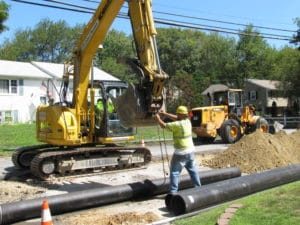
By now, everyone has heard of the water crisis that occurred in Flint, Michigan when the City switched the source of its municipal water from the Detroit system to the Flint River in an effort to cut costs. Anti-corrosion chemicals were not added to the water, allowing lead to leach from the City’s aging pipes into the water supply. In the aftermath, hundreds of children suffered lead poisoning, officials were fired, arrests were made, and lawsuits were filed. And while the Flint disaster was arguably terrible and tragic, it has brought much-needed attention to the state of our nation’s infrastructure, and the criticality of maintaining and improving it.
Lead Service Lines in the United States
There are an estimated six million lead pipes remaining in use in the United States, utilized by over 11,000 water systems that serve nearly 22 million Americans, yet there is no federal plan in place to replace these lead service lines. Why? First, it would cost an exorbitant amount of money — roughly $30 billion — to replace every single remaining lead service line, money that utilities simply do not have. With failing infrastructure, dwindling budgets, more stringent regulatory requirements, and increased demand, utilities are doing everything they can simply to maintain service and compliance. To mitigate lead in drinking water, utilities that are unable to dig up all their lead service lines are instead treating water so that it forms a coating on the interior of the pipes. This coating serves as a protective barrier between the water and the lead pipes, preventing lead from leaching into the water supply. This methodology requires extreme vigilance, as water chemistry often changes, which can cause corrosion controls to fail. Fortunately, utilities regularly test their water for lead contamination, and on February 29, 2016, the EPA changed testing regulations to more accurately reflect the amount of lead in drinking water.
Lead in the Drinking Water of Public Schools
 While utilities are working diligently to keep our nation’s water lead-free, public schools have recently come under fire, as schools from cities across the nation — including Boston, Massachusetts; Ithaca, New York; Portland, Oregon; and Tacoma, Washington — have found lead in their drinking water above the EPA’s action level of 15 parts per billion. Surprisingly, this contamination is the result of a legal loophole that many states are looking to close: schools are mandated by the EPA to be connected to a water supply that is regularly tested for lead and other contaminants; however, these utilities are not typically required to actually test the water inside the schools themselves. Considering that the average age of a school in the United States is 44 years old, it should come as no surprise that there are elevated levels of lead in the drinking water of public schools. After all, lead pipes were legal until about 30 years ago, and faucets and fixtures were allowed to contain up to 8% lead until 2014.
While utilities are working diligently to keep our nation’s water lead-free, public schools have recently come under fire, as schools from cities across the nation — including Boston, Massachusetts; Ithaca, New York; Portland, Oregon; and Tacoma, Washington — have found lead in their drinking water above the EPA’s action level of 15 parts per billion. Surprisingly, this contamination is the result of a legal loophole that many states are looking to close: schools are mandated by the EPA to be connected to a water supply that is regularly tested for lead and other contaminants; however, these utilities are not typically required to actually test the water inside the schools themselves. Considering that the average age of a school in the United States is 44 years old, it should come as no surprise that there are elevated levels of lead in the drinking water of public schools. After all, lead pipes were legal until about 30 years ago, and faucets and fixtures were allowed to contain up to 8% lead until 2014.
Lead poisoning is particularly detrimental to school-aged children, and public outcry — largely as a result of Flint’s crisis — has spurred many schools to voluntarily test their water. The findings have been shocking to parents and educators, as school across the nation, from Maine to Washington state, are reporting lead levels above the EPA’s action level. Every day, another news story crops up with a report on elevated lead in a county’s school system, and it becomes apparent that our nation has a serious problem on its hands. Just as with water utilities, the ideal solution would be to replace all the lead pipes and fixtures in our nation’s schools, but again, funding for large-scale replacement just isn’t available. Instead, many schools have turned to lead filters, which work extremely well when maintained regularly.
Looking Ahead
 Many states have introduced legislation this year that would require public schools to regularly test their water. Bills on the table in Michigan, New Jersey, North Carolina, and Rhode Island would require regular testing, as would a New York bill that takes it one step further by providing funding for said testing. In addition, the New York bill would require schools to notify parents and to provide an alternate supply of safe drinking water to students if elevated lead levels are found. In Massachusetts, all community water systems are required by Massachusetts drinking water regulations to collect lead and copper samples from at least two schools or early education and care program facilities that they serve in each sampling period, when they collect their Lead and Copper Rule (LCR) samples. In addition, in April of 2016, it was announced that $2 million from the Massachusetts Clean Water Trust (MCWT) will fund cooperative efforts to help Massachusetts public schools test for lead and copper in drinking water. The funds, to be used by the Massachusetts Department of Environmental Protection (MassDEP), will provide technical assistance to ensure that public school districts can sample the taps and water fountains in their schools, and to identify any results that show lead and copper contamination over the action level. On a federal level, legislation has been introduced to Congress that would requires states to assist schools with testing for lead; however, it does not provide funding.
Many states have introduced legislation this year that would require public schools to regularly test their water. Bills on the table in Michigan, New Jersey, North Carolina, and Rhode Island would require regular testing, as would a New York bill that takes it one step further by providing funding for said testing. In addition, the New York bill would require schools to notify parents and to provide an alternate supply of safe drinking water to students if elevated lead levels are found. In Massachusetts, all community water systems are required by Massachusetts drinking water regulations to collect lead and copper samples from at least two schools or early education and care program facilities that they serve in each sampling period, when they collect their Lead and Copper Rule (LCR) samples. In addition, in April of 2016, it was announced that $2 million from the Massachusetts Clean Water Trust (MCWT) will fund cooperative efforts to help Massachusetts public schools test for lead and copper in drinking water. The funds, to be used by the Massachusetts Department of Environmental Protection (MassDEP), will provide technical assistance to ensure that public school districts can sample the taps and water fountains in their schools, and to identify any results that show lead and copper contamination over the action level. On a federal level, legislation has been introduced to Congress that would requires states to assist schools with testing for lead; however, it does not provide funding.
In Conclusion
As long as lead service lines and plumbing remain in use in our nation, there remains a risk of lead contamination of our drinking water. Utilities, states, and schools are doing what they can to limit this risk as much as possible, but the only fail safe solution is full replacement of all lead service lines and fixtures — a massive undertaking that will require significant capital investment that is not currently available. Therefore, it is imperative that utilities and schools continue to remain vigilant about testing for and mitigating lead in drinking water, even after the public outcry from Flint has faded.
